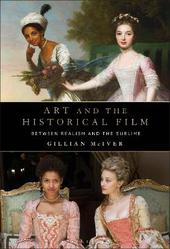
|
Art and the Historical Film: Between Realism and the Sublime
Hardback
Main Details
| Title |
Art and the Historical Film: Between Realism and the Sublime
|
| Authors and Contributors |
By (author) Dr Gillian McIver
|
| Physical Properties |
| Format:Hardback | | Pages:280 | | Dimensions(mm): Height 229,Width 152 |
|
| Category/Genre | Theory of art
Film theory and criticism |
|---|
| ISBN/Barcode |
9781501384769
|
| Classifications | Dewey:791.43658 |
|---|
| Audience | | Professional & Vocational | |
|---|
| Illustrations |
14 bw illus
|
|
Publishing Details |
| Publisher |
Bloomsbury Publishing Plc
|
| Imprint |
Bloomsbury Academic USA
|
| Publication Date |
15 December 2022 |
| Publication Country |
United States
|
Description
From Eugene Delacroix's interpretation of the 1830 French revolution to Uli Edel's version of the Baader-Meinhof Gang, artistic representations of historical subjects are appealing and pervasive. Movies often adapt imagery from art history, including paintings of historical events. Films and art shape the past for us and continue to affect our interpretation of history. While historical films are often argued over for their adherence to "the facts," their real problem is realism: how can the past be convincingly depicted? Realism in the historical film genre is often nourished and given credibility by its use of painterly references. This book examines how art-historical images affect historical films by going beyond period detail and surface design to look at how profound ideas about history are communicated through pictures. Art and the Historical Film: Between Realism and the Sublime is based on case studies that explore the links between art and cinema, including American independent Western Meek's Cutoff (Kelly Reichardt, 2010), British heritage film Belle (Amma Asante, 2013), and Dutch national epic Admiral (Roel Reine, 2014). The chapters create immersive worlds that communicate distinct ideas about the past through cinematography, production design, and direction, as the films adapt, reference, and transpose paintings by artists such as Rubens, Albert Bierstadt, and Jacques-Louis David.
Author Biography
Gillian McIver studied History at the University of Toronto, Canada, and completed a PhD in Art History and Cinema at the University of Roehampton, UK. She has lectured at Central St Martins, The National Film and Television School, and the University for the Creative Arts, UK. She is the author of Art History for Filmmakers (Bloomsbury, 2016).
ReviewsA thoughtful exploration of the relationship between art and cinema in the historical film, a relationship that McIver construes in terms of a tension between a quest for authenticity and realism and the desire to create an immersive world provoking intense emotional engagement, Art and the Historical Film: Between Realism and the Sublime (2022) provides a probing and remarkably wide-ranging analysis of the complex ways in which art has shaped the past for us. Grounding her discussion in the growing number of interdisciplinary studies on the relationship between art and cinema, McIver offers a fresh look at the different ways in which historical films like Girl with a Pearl Earring, Meek's Cutoff, The Baader-Meinhof Complex, The Mummy: The Night of Counting the Years, and Admiral adapt, transpose, invoke, evoke, or reference paintings by artists like Rubens, Albert Bierstadt, and Jacques-Louis David to communicate specific ideas about the past. * Temenuga Trifonova, Associate Professor of Cinema and Media Studies, York University, Canada * Art and the Historical Film: Between Realism and the Sublime approaches a handful of historical films with a welcome focus on various ways that art history is reflected or incorporated in their cinematic rhetoric. From speculative biopics inspired by portraits to narratives based on historical record in which painterly precedents-quoted or invoked-provide a sense of authenticity, realism, sublimity, or spectacle, Gillian McIver thinks through a dialectic between art and cinema as it informs historical representation, sometimes surprisingly, as with The Baader Meinhoff Complex, a film that is not only set within historical memory but which hews closely to a journalistic account, depicting events well-known from mass media. The book offers a thought-provoking frame for contemplating the meanings and emotions with which art infuses historical narratives. * Susan Felleman, Professor of Art History and Film and Media Studies, University of South Carolina, USA * Art and the Historical Film: Between Realism and the Sublime explores the dialogue between the painterly and the cinematic in a compelling selection of international films. This is a work of interdisciplinary ambition that expands the aesthetic vocabulary of art and historical representation in the cinema. Written in an accessible and engaging style, Gillian McIver's book reclaims the historical film image in all its complexity and appeal. * Belen Vidal, Reader in Film Studies, King's College London, UK, and author of Figuring the Past. Period Film and the Mannerist Aesthetic (2012) *
|